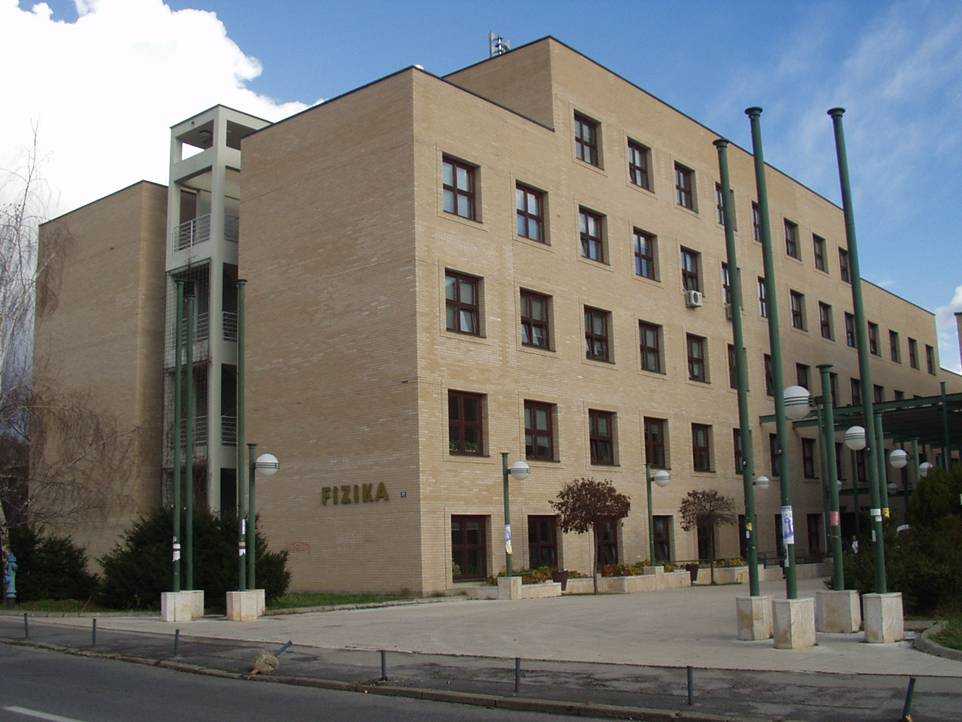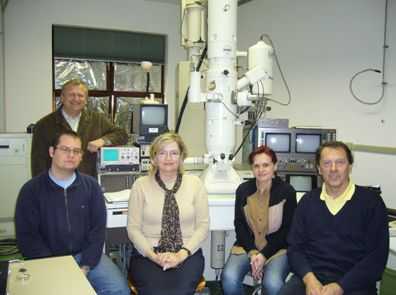|
4.1
Department of Physics, Faculty of Science, University of Zagreb
Antun Tonejc
The earliest crystallographic activity at the Department of Physics
of the Faculty of Science, University of Zagreb, begun with the PhD
work of Katarina Kranjc (1915- †1989), Investigation of
 poly-dispersive
systems with the aid of small-angle X-ray diffraction in 1954. Her
supervisor was Professor Mladen Paić (1905-†1997), Head of the
Department of Physics, who initiated crystallography at the Department.
He was familiar with the Debye-Scherrer technique, which he used for
experimental work in his PhD thesis performed at the University of
Sorbonne in Paris in years 1930-1932. In 1946 he was appointed Head of
the Department of Physics (1946-1970) and since then stimulated
crystallography research. At the beginning only a Unicam-25 camera was
at disposal. Until her retirement as full professor in 1985, K. Kranjc
continued to use SAX in the research, but also Berg-Barrett X-ray
diffraction microscopy to investigate the domain structure (Quantitative
investigation of domain structures by Berg-Barrett X-ray Diffraction
Microscopy, J.Appl.Cryst. 1 (1968) 227) and Moiré
fringes in electron micrographs. She was a friend with Rosalind
Franklin who visited Zagreb in 1953 and gave a lecture on X-ray
diffraction. In 1954 K. Kranjc worked in Paris in the laboratory of
André Guinier at the Faculté des Sciences, Orsay, and in 1958 spent a
six month long post doc at the Department of Crystallography, Birkbeck
College, University of London (in the Alan Mackay group). poly-dispersive
systems with the aid of small-angle X-ray diffraction in 1954. Her
supervisor was Professor Mladen Paić (1905-†1997), Head of the
Department of Physics, who initiated crystallography at the Department.
He was familiar with the Debye-Scherrer technique, which he used for
experimental work in his PhD thesis performed at the University of
Sorbonne in Paris in years 1930-1932. In 1946 he was appointed Head of
the Department of Physics (1946-1970) and since then stimulated
crystallography research. At the beginning only a Unicam-25 camera was
at disposal. Until her retirement as full professor in 1985, K. Kranjc
continued to use SAX in the research, but also Berg-Barrett X-ray
diffraction microscopy to investigate the domain structure (Quantitative
investigation of domain structures by Berg-Barrett X-ray Diffraction
Microscopy, J.Appl.Cryst. 1 (1968) 227) and Moiré
fringes in electron micrographs. She was a friend with Rosalind
Franklin who visited Zagreb in 1953 and gave a lecture on X-ray
diffraction. In 1954 K. Kranjc worked in Paris in the laboratory of
André Guinier at the Faculté des Sciences, Orsay, and in 1958 spent a
six month long post doc at the Department of Crystallography, Birkbeck
College, University of London (in the Alan Mackay group).
Antun Bonefačić (1925- ) joined the Department in 1960 and received
his PhD in 1963 (X-ray structural analysis of some Ag-II sulfates).
Again, M. Paić was the supervisor. A two-years long post doc (1964
and 1965) A. Bonefačić performed in the laboratory of Andre Guinier.
There he worked on diffuse scattering produced by thermal lattice
vibrations (X-Ray Study of Difusse Streak Diffraction Pattern from
Silicon Single Crystals, Acta Cryst. 14 (1969) 589). In 1966
he became the Head of the research group Physics of Metals, and full
prosessor in 1975. In 1971 A. Bonefačić received the Croatian
National Science Award for
Physics for his
scientific research on crystallographic properties of metastable
alloys.
Numerous young researches joined Bonefačić in 1966 (Dragan Kunstelj,
Mirko Stubičar, Anđelka Tonejc and Antun Tonejc). In 1967 Bonefačić and
his assistants initiated structural research in the area of metastable metallic alloys obtained by rapid quenching from
the melt using X-ray powder diffraction and electron microscopy. The
instruments were Siemens X-ray diffraction unit (purchased in 1966) and
Philips 120 kV transmission electron microscope EM300 (purchased in
1970). Anđelka Tonejc made her post doc also in the Lab of André Guinier
at the Faculté des Sciences, Orsay, from 1974 to 1976. There she worked
on rapidly quenched alloys using X-ray powder diffraction and TEM.
the area of metastable metallic alloys obtained by rapid quenching from
the melt using X-ray powder diffraction and electron microscopy. The
instruments were Siemens X-ray diffraction unit (purchased in 1966) and
Philips 120 kV transmission electron microscope EM300 (purchased in
1970). Anđelka Tonejc made her post doc also in the Lab of André Guinier
at the Faculté des Sciences, Orsay, from 1974 to 1976. There she worked
on rapidly quenched alloys using X-ray powder diffraction and TEM.
In 1991 Department of Physics moved into the new building and Antun
Tonejc established the Laboratory for Microstructural Investigation of
Materials with two new purchased instruments, Philips X-ray powder
diffractometer and JEOL 200kV high-resolution transmission electron
microscope. After the retirement of Professor Bonefačić in 1995, Antun
Tonejc became the Head of the Laboratory. Stanko Popović joined the
Laboratory in 1987 as full professor (on leave from Rudjer Bošković
Institute; he retired in 2008), and later also young assistants Davorin
Bagović (from 1992 to1995), Igor Đerđ (from 1998 to 2008, now at the
Ruđer Bošković Institute), Željko Skoko (in 2000), and Ivana Lončarek
(in 2006).
Anđelka Tonejc has
focused her research on high-resolution electron microscopy
investigation ( HRTEM: image processing
analysis of defects and grain boundaries in nanocrystalline materials,
Acta Chim.Sloven. 46 (1999) 435)
and, with Igor Đerđ, was one of the first researchers
who used the Rietveld method for electron diffraction analysis (Structural
investigations of nanocrystalline TiO2 samples, J.Alloys
Comp. 413
(2006) 159).
In 1990 Antun Tonejc
initiated structural examination of mechanically alloyed materials using
high-energy ball milling (Crystallographic
features of mechanically milled and alloyed
nanosized and amorphous materials,
Acta Chim.Slov. 49 (2002) 1), and received the Science Award
of Croatian Academy of Sciences and Arts in 2008 for structural
investigations of phases and phase transitions in nanostructural
materials prepared by extreme techniques.
Stanko Popović has mainly focused on X-ray diffraction line profile
analysis (Reliability
of the simplified integral-breadth methods in diffraction
line-broadening analysis, J.Appl.Cryst. 29 (1996) 16),
on microstructural investigations of Al-Zn and Al-Ag-Zn alloys (
Phys.Stat.Sol. A140 (1993) 341; Croat.Chem.Acta 82
(2009) 405; Z. Krist. 30 Suppl (2009)309), and on
mixed metal oxides in collaboration with the Department of Materials
Chemistry, Rudjer Bošković Institute. He
received Croatian National Science Award for Physics for X-ray
diffraction line profile and quantitative phase analyses
(2001), and became Fellow of Croatian Academy of Sciences and Arts
(2004).
Laboratory for
Microstructural Investigation of Materials at Department of Physics has
been the leading laboratory for microstructural investigations of
materials in Croatia.
At the Physics Department
undergraduate and postgraduate courses are taught on
solid state physics and crystallography.
|